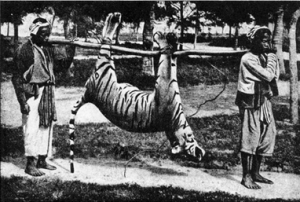News
Latest Lion Aid News
Tigers are worth more dead than alive
Friday 6th July 2012
|
At a meeting in St Petersburg at the end of 2010 donors came together to raise much needed funds to save tigers. The conference was hosted by the then Prime Minister of Russia Vladimir Putin (now President again) and guests included representatives from the World Bank, Chinese Premier Wen Jiabo, and celebrities Leonardo DiCaprio and Naomi Campbell. If we accept that there are 3,200 tigers left in the world (actually, only two of the nine tiger subspecies have enough individuals to remain possibly viable, four subspecies are extinct, and the other three are critically endangered) – the donors pledged something like £66,000 per live tiger. We all know that pledges are very different than cash in hand, but that seems to represent the worth of a tiger to potential donors. Now, what we have to also realize is that a half bottle (350ml) of tiger bone wine made in the 1980’s in China is selling at £6,000. So eleven small bottles equals the value of a whole tiger… Tiger bone wine is made in vats where rice wine is added to a tiger skeleton and allowed to stew. Perhaps a few other ingredients are added, and the product is supposed to stave off chills, improve circulation, eliminate fatigue and help with rheumatism. While not being a practitioner of Asian Traditional Medicine, I would pose to you that a tiger’s bones brewed up in wine is going to be worth 20-30 times more than a live tiger value decided at St Petersburg. In economic terms, you can go to South Africa and trophy hunt a rhino for about $55,000. The horn is worth $65,000 per kilo, and an average white rhino bears about 6 kilos of horn – so $390,000 – a nice and entirely legal profit that many are taking advantage of. A pair of tusks is similarly worth more than the hunting costs of an elephant. So from a purely economic point of view, the price people are willing to pay for wildlife products exceeds the value of the living animal. And the more rhinos, tigers, elephants are killed, the more valuable their products will become as they get scarcer. And the more those animals will be poached, since the profit margins and benefit to risk ratios keep getting higher. The disconnect is that we have a real and realizable value placed on dead animals but not on live ones. Is a tiger only worth £66,000 alive? What is the worth of a live wild rhino? How much is a living elephant worth? As long as we cannot decide, we are putting market values on what is dead. You might say that wildlife tourism is worth huge sums to African countries, and that is true. But that value is meaningless to the crime syndicates who cannot even pronounce the word biodiversity properly, let alone know what it means. This, my friends, is the reality. Animals will become increasingly more market valuable the more they die. There will be someone willing to pay very many millions so he can say he shot the last lion in Africa. Those of us who would like to keep animals alive need to catch up and pay attention. Unless there is positive finance to conserve our biodiversity, we are going to be left with what remains alive in zoos, mounted in museums, and viewed on old wildlife films. So what can be done? Better policing and law enforcement for sure. Much higher sentences for commercial poachers and much better monitoring of airports and harbours to reduce the inflow of illegal products. No more legal loopholes that allow pseudo-trophy hunting in South Africa and no more sales by South Africa of rhino horns and lion bones to Asian countries. No more legal ivory sales allowed by CITES. Reverse the current benefit to risk ratio for commercial poachers. Just for a start? Tags: CITES, South Africa, elephants, rhinos, Tigers, tiger bone wine, Categories: Illegal Wildlife Trade |
Posted by Pieter Kat at 15:36
No comments have been posted yet.
Add a new comment
Existing user
New user sign up




